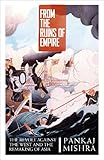
From the Ruins of Empire: The Revolt Against the West and the Remaking of Asia
- 作者: Pankaj Mishra
- 出版社/メーカー: Allen Lane
- 発売日: 2012/08/02
- メディア: ハードカバー
- クリック: 2回
- この商品を含むブログを見る
Pankaji Mishra From the Ruins of Empire*1から。
岡倉天心(岡倉覚三)*2を巡って;
Okakura had been alerted to Japan's cultural heritage by his American teacher Ernest Fenollosa, an art historian and philosopher who believed that it was Asia's destiny to spiritualize the modern West. Just as Western Orietal scholarship about India informed Tagore's views of Asia and theWest, so did Fenollosa's Japanophilia suffuse Okakura's idealized notion of Asian unity. He had spent a year in India in 1901-2, staying for some of this time in the Tagore family's mansion in Calcutta, where he drafted The Ideals of the East and influenced a host of Indian artists. Tagore subsequently received a stream of Japanese visitors sent by Okakura at his rural retreat in Santiniketan; and Okakura himself revisited India in 1911 on his way o Boston, where he was now a curator at the Museum of Fine Arts. Okakura was to become a major influence on such varied figures as Frank Lloyd Wright, T.S. Eliot, Wallace Stevens, Ezra Pound and even Martin Heidegger. In Tagore, however, he found a fellow traveller, someone also prone to uphold Asia's oneness and investigate the moral claims of the West. (…) (pp.230-231)
*1:Mentioned in http://d.hatena.ne.jp/sumita-m/20121208/1354948878 http://d.hatena.ne.jp/sumita-m/20140827/1409108595 http://d.hatena.ne.jp/sumita-m/20141113/1415857315
*2:See also http://d.hatena.ne.jp/sumita-m/20060316/1142527872 http://d.hatena.ne.jp/sumita-m/20080904/1220533385 http://d.hatena.ne.jp/sumita-m/20101212/1292124745 http://d.hatena.ne.jp/sumita-m/20101222/1293039677 http://d.hatena.ne.jp/sumita-m/20110324/1300899151